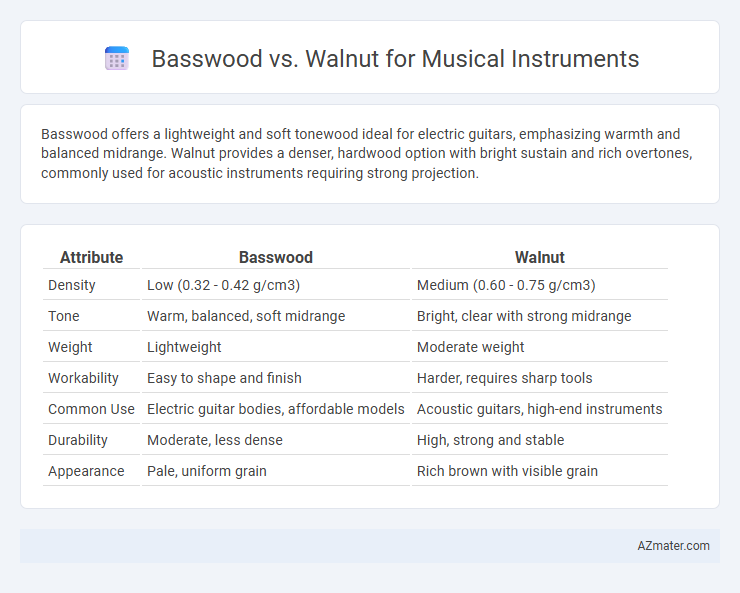Basswood offers a lightweight and soft tonewood ideal for electric guitars, emphasizing warmth and balanced midrange. Walnut provides a denser, hardwood option with bright sustain and rich overtones, commonly used for acoustic instruments requiring strong projection.
Table of Comparison
| Attribute | Basswood | Walnut |
|---|---|---|
| Density | Low (0.32 - 0.42 g/cm3) | Medium (0.60 - 0.75 g/cm3) |
| Tone | Warm, balanced, soft midrange | Bright, clear with strong midrange |
| Weight | Lightweight | Moderate weight |
| Workability | Easy to shape and finish | Harder, requires sharp tools |
| Common Use | Electric guitar bodies, affordable models | Acoustic guitars, high-end instruments |
| Durability | Moderate, less dense | High, strong and stable |
| Appearance | Pale, uniform grain | Rich brown with visible grain |
Overview: Basswood vs Walnut for Musical Instruments
Basswood offers a lightweight, soft texture with excellent resonance, making it ideal for electric guitar bodies and amplifying midrange frequencies clearly. Walnut provides a denser, harder wood with rich tonal depth, strong sustain, and a warm, balanced sound favored in acoustic guitars and high-end string instruments. Both woods influence instrument durability and tonal characteristics, with basswood excelling in affordability and playability, while walnut is prized for aesthetic appeal and complex sound quality.
Physical Properties Comparison
Basswood offers a lightweight and softer texture with a Janka hardness of approximately 410, making it easier to carve and shape for musical instruments but less durable compared to walnut. Walnut, possessing a higher Janka hardness around 1,010, provides enhanced strength and density, contributing to better sustain and resonance in instruments like guitars and violins. The contrasting densities--basswood around 0.32 g/cm3 and walnut about 0.64 g/cm3--affect tonal qualities, with basswood producing a warmer, softer sound while walnut delivers richer, brighter tones suitable for high-end instrument craftsmanship.
Tonal Characteristics and Sound Quality
Basswood offers a warm, balanced tonal profile with a soft midrange and smooth highs, making it ideal for producing clear, articulate sound in musical instruments. Walnut provides a richer, more complex tone with pronounced midrange resonance and a bright, snappy attack, delivering enhanced sustain and dynamic response. Musicians seeking a versatile sound with warm character prefer basswood, while those aiming for detailed articulation and greater tonal depth often choose walnut.
Workability and Ease of Shaping
Basswood offers exceptional workability and ease of shaping due to its soft texture and fine, even grain, making it a preferred choice for intricate musical instrument carvings and detailed craftsmanship. Walnut, while harder and denser, provides excellent strength and a rich tonal quality but requires more effort and sharper tools for precise shaping and fine detailing. Both woods serve different purposes in instrument making, with basswood favored for ease of manipulation and walnut chosen for durability and aesthetic appeal.
Durability and Longevity
Walnut offers superior durability and longevity compared to basswood, making it a preferred choice for musical instruments that require resilient wood able to withstand frequent playing and environmental changes. Basswood is softer and more prone to dents and wear over time, which may affect the instrument's structural integrity and tonal consistency. Walnut's dense grain structure not only enhances durability but also contributes to a longer lifespan, preserving the instrument's quality and sound.
Weight and Playability Differences
Basswood is significantly lighter than walnut, making it a preferred choice for musicians seeking easier handling and reduced fatigue during long playing sessions. Walnut, while heavier, offers a denser feel that can enhance sustain and tonal richness but may be less comfortable for extended use. The weight difference affects playability by influencing balance and responsiveness, with basswood providing a more agile experience and walnut delivering a sturdier, more resonant instrument body.
Aesthetic Appeal and Grain Patterns
Basswood offers a pale, uniform appearance with subtle grain patterns that provide a smooth, consistent aesthetic ideal for painted or finished instruments. Walnut features rich, dark hues with pronounced, swirling grain patterns that create a striking visual contrast and a sophisticated, natural elegance. Musicians and luthiers often choose walnut to highlight craftsmanship through its distinctive grain, while basswood appeals for its clean, understated look.
Cost and Availability
Basswood offers an affordable and widely available option for musical instruments, making it popular for entry-level and mid-range guitars and ukuleles. Walnut, while more expensive and less abundant, provides a unique tonal warmth and aesthetic appeal valued by professional luthiers and musicians seeking premium instruments. The cost difference reflects walnut's scarcity and higher demand in custom and high-end instrument markets.
Suitability for Different Musical Instruments
Basswood offers a lightweight, soft tonewood ideal for electric guitars and basses, providing a balanced sound with strong mids and smooth highs. Walnut, known for its dense, hardwood properties, delivers bright attack and rich sustain, making it suitable for acoustic guitars, drum shells, and ukuleles that require durability and clear resonance. The choice between basswood and walnut depends on the desired tonal quality and instrument type, with basswood favoring amplified instruments and walnut excelling in acoustic applications.
Choosing the Right Wood: Factors to Consider
Basswood offers a lightweight and soft texture ideal for producing warm, balanced tones and is often favored in electric guitars for its affordability and ease of shaping. Walnut provides a dense, hard surface that delivers bright, clear resonance with strong sustain, preferred for acoustic instruments needing projection and visual appeal. When choosing between basswood and walnut for musical instruments, consider factors such as tonal preference, weight, durability, and aesthetic value to match the instrument's purpose and playing style.

Infographic: Basswood vs Walnut for Musical instrument
 azmater.com
azmater.com